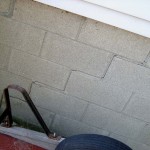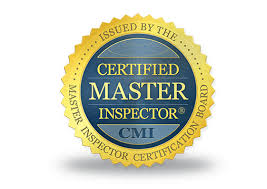The word concrete comes from the Latin word “concretus” (meaning compact or condensed), the perfect passive participle of “concrescere”, from “con-” (together) and “crescere” (to grow). Most information available about concrete is written for contractors, for those who design concrete mixes, and for those who perform invasive testing.
In evaluating concrete problems, one of the important decisions home inspectors must make is determining whether a problem is the result of conditions that have stabilized with a low chance of continuing future problems, or whether the conditions that caused the problem are such that there is a high probability that problems will continue or worsen.
Different factors can affect concrete and the problems that inspectors will see. How concrete hardens, strengthens and the qualities of its surface depend on a number of things, including the properties of its constituent materials. Although Portland cement is the most commonly used binder, pozzolans may be substituted. Pozzolans are materials that, in addition to undergoing primary hydration, undergo a secondary hydration, producing a gel that fills tiny voids between cement particles, making concrete less porous and less likely to absorb moisture or chemical solutions that can damage concrete or steel reinforcement.
The constituent materials which are included in the mix, their proportions, the order in which they are combined, the length of time and method by which they are mixed, and the length of time between mixing to placing all affect the quality of concrete. With each decision and operation, there is a chance that mistakes will be made. The environmental conditions that exist during placing, finishing and curing concrete will have an effect on how it develops. The ground and air temperatures, wind speed, cloud cover, and the absorbent qualities of the substrate will affect newly placed concrete.
When initially mixed together, Portland cement and water rapidly form a gel, formed of tangled chains of interlocking crystals. These continue to react over time, with the initially fluid gel often aiding in placement by improving workability. As the concrete sets, the chains of crystals join and form a rigid structure, gluing the aggregate particles in place. During curing, more of the cement reacts with the residual water (hydration). This curing process develops physical and chemical properties. Among these qualities are mechanical strength, low moisture permeability and chemical and volumetric stability.
 Cracks that appear before the concrete has hardened are called plastic cracks. Plastic cracks are typically due to poor mix design, placement practices or curing methods, and may also be caused by settlement, construction movement, and excessively high rates of evaporation. Cracks that appear after concrete has hardened can have a variety of causes, and sometimes have more than one cause.
Cracks that appear before the concrete has hardened are called plastic cracks. Plastic cracks are typically due to poor mix design, placement practices or curing methods, and may also be caused by settlement, construction movement, and excessively high rates of evaporation. Cracks that appear after concrete has hardened can have a variety of causes, and sometimes have more than one cause.
Plastic shrinkage is shrinkage caused by the loss of water to the atmosphere. Autogenous shrinkage is shrinkage that takes place with no loss of water to the atmosphere. Autogenous shrinkage is caused by internal drying, with water being absorbed by the constituent materials in the concrete. As the long-term chemical hydration process continues – and it can continue for many years — water in the pores within the cement paste is absorbed, and the pores are filled, to some degree, by materials produced during hydration. This process leads to decreased permeability and increased strength and durability of the cement paste. Absorption of water from the pores also causes shrinkage.
When purchasing a new property it is important to have the building inspected by a qualified residential or commercial inspector. Trust the Barrie Home Inspector for your Residential or Commercial Inspections. Visit www.guaranteedresidentialinspections.com for more information. As a Certified Building Code Official with over 4,000 inspections your investment will be in good hands. Experience and knowledge can help protect your investment.
